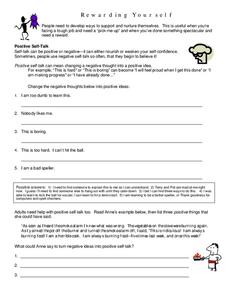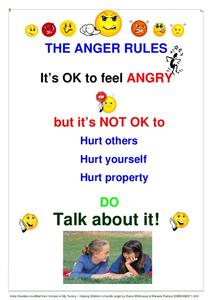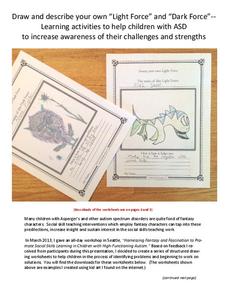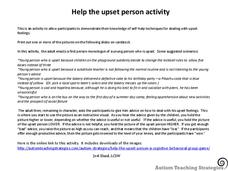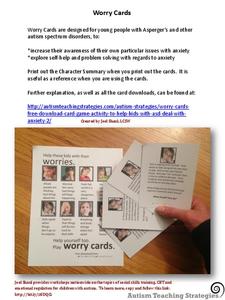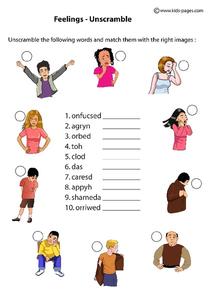Ohio National Guard
Emotional Intelligence
Guide young learners through the tumultuous emotions of growing up with a set of worksheets about self-esteem and empathy. Each worksheet focuses on a different skill, allowing youngsters to work through their feelings and relate to...
University of Washington
Rewarding Yourself
Everyone experiences negative self-talk from time to time, but how can youngsters learn to take it easy on themselves? Use an activity that focuses on talking positively to oneself, including giving yourself compliments and spending time...
ESL Kid Stuff
Feelings & Emotions
Sometimes it can be hard to express emotions. Help little learners figure out what makes them happy, angry, sad, or scared with a instructional activity that focuses on feelings. It includes singing, drawing, matching flashcards, and more.
PBS
Robot Body Language
How can you tell what someone is feeling when they aren't saying a word? Explore non-verbal communication with an activity based on Cynthia Breazeal's work with expressive robots. One learner puts a bag over his or her face and uses body...
Flourish N Thrive Counseling
A Volcano in My Tummy (Helping Children to Handle Anger)
Sometimes it's hard for kids to express their anger appropriately, or to understand what is happening to their bodies when they feel angry. An insightful lesson about anger management can help them identify angry feelings. It includes a...
Elaine Whithouse & Warwick Pudney
The Anger Rules
What's a healthy way to express your anger? A classroom poster informs kids that feeling angry is all right, but hurting others, yourself, or property is not.
Curated OER
Filtering Angry Statements Activity
Help learners who struggle with blurting out statements when they are angry by reviewing a series of statements and determining when, if ever, they are appropriate to say.
Social Skills Central
Don't Get Mad...
Pupils discover important alternatives to expressing anger and how to better manage their emotions through a collaborative discussion activity with their classmates. This resource includes nearly 100 (99, to be exact!) hypothetical...
Curated OER
Paper Fortune Tellers for Exploring Upsetting Emotions
What kinds of thoughts help us to cope with problems and approach difficult situations? Support learners on the autism spectrum in exploring their emotions and considering the connection between our thoughts and our feelings using one of...
Curated OER
Minting New Thoughts
Consider a new metaphor when discussing positive thinking with your learners by having them "recycle" their negative, poison thoughts and "minting" them into positive ones using these dollar bill printables!
Curated OER
“Light Force” and “Dark Force”
Designed for learners with autism, this set of worksheets prompts students to design their own fantasy characters as a way of identifying emotional problems and solutions they might face on a daily basis.
Curated OER
Help the Upset Person Activity
Assess what self-help techniques your students know for dealing with upset emotions with this conversational activity. The teacher begins by role playing as an upset individual, using visual images as prompts, and then asks students for...
Curated OER
Worry Cards
Help learners on the autism spectrum build awareness of their feelings of anxiety through a hands-on learning activity. Using a set of cards with examples of the different types of anxiety someone might face, learners discuss ideas of...
Do2Learn
Social: Emotions, Health, and People
Picture cards can be a fantastic tool that learners can utilize to communicate their emotions and needs. This set of cards illustrates not only basic emotions, such as happiness, fear, or anger, but also certain illnesses a person might...
Learning for Life
Anger/Conflict Management
What is anger? Why do we become angry, and how can we control it? Help young learners develop an important life skill in the ability to process and handle angry emotions with this simple guided activity and worksheet.
Kids' Pages
Feelings Unscramble
After youngsters have learned about different human emotions, challenge them to unscramble this list of feelings in this instructional activity based on the images provided.
Kids' Pages
Opposite Feelings
Develop critical thinking skills and emotional development with a activity, in which learners identify a variety of feelings and their opposites through a matching activity.
Kids' Pages
Feelings Fill In 2
Fill in the blanks for ten emotion words with an educational worksheet. After kids examine each picture of a person experiencing a feeling, they define the emotion and fill in the missing vowels to complete the word.
Kids' Pages
Feelings Fill In
How does it feel when you don't get your favorite toy? Explore emotion words with an exercise that provides pictures and descriptions of people in different situations. Kids choose from a word bank to fill in the blanks for people who...
Elementary School Counseling
My Animal's Name Is:
How can others help when we're feeling strong emotions? Help your learners express how they feel by naming and drawing an animal who feels a certain emotion. They write in the emotion and then describe why the animal feels that way, as...
Kids' Pages
Feelings Definitions
What is one word to identify someone who cannot think clearly? From confusion and anger to happiness and exhaustion, young learners practice defining basic feelings and emotions by matching terms to their appropriate fill-in-the-blank...
Kids' Pages
Feelings/Emotions Matching
When you are feeling thirsty, you should...go to bed? Using common phrases and clip art images, youngsters practice matching feelings to what their appropriate responses should be.
Curated OER
Cognitive Triangle Worksheet
What you tell yourself about an event can have a profound effect on what you actually do about it. Encourage learners to examine their thoughts, and how these thoughts eventually translate into feelings and actions, with a worksheet that...
Kids' Pages
Feelings Matching 2
What does it look like when someone is feeling sad, worried, hungry, or happy? These are some of the emotions that your youngsters will identify in a simple matching activity.



